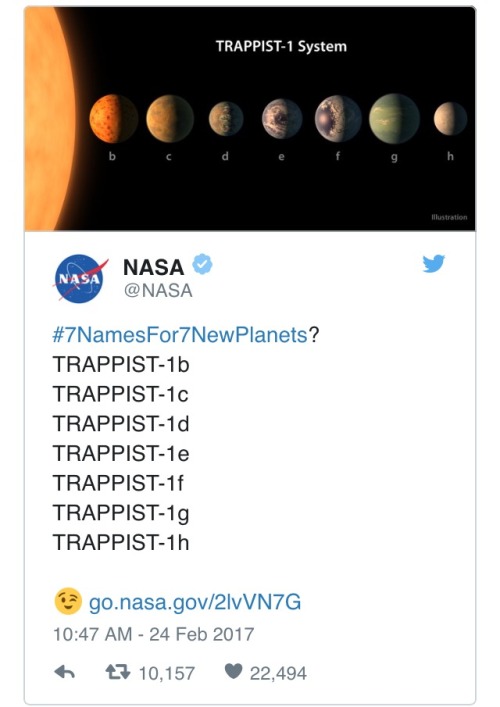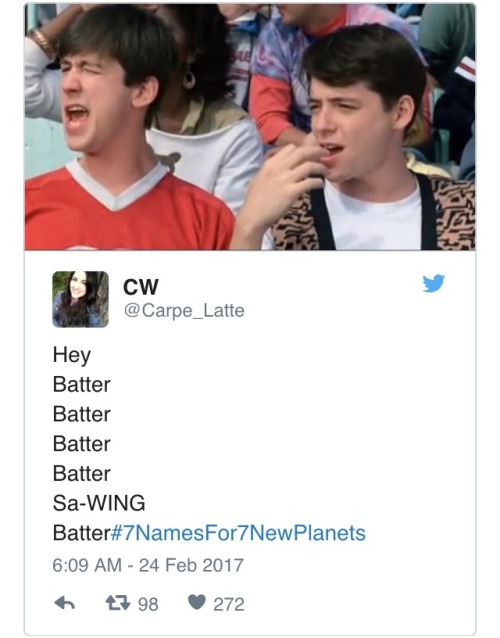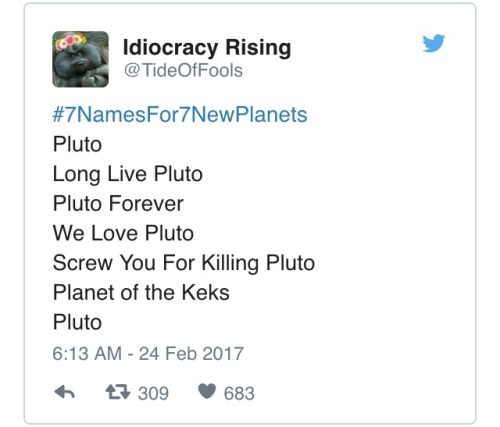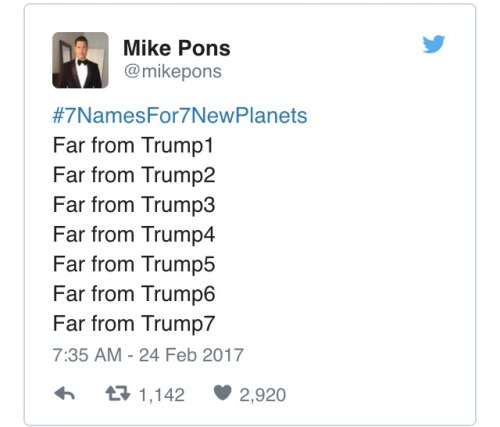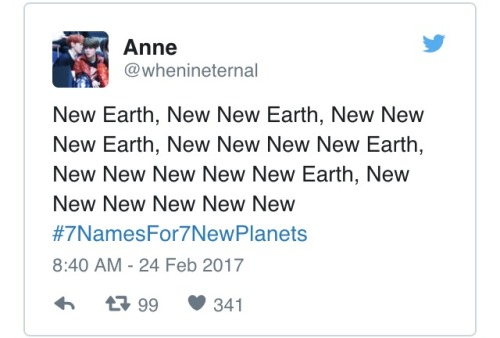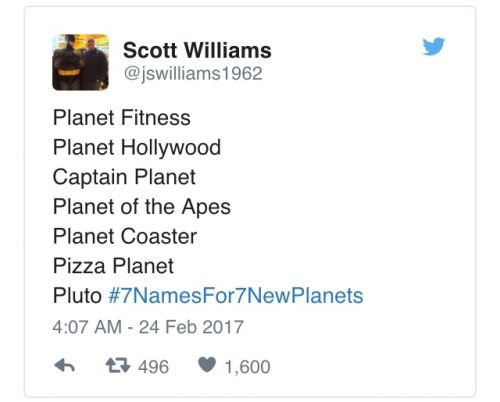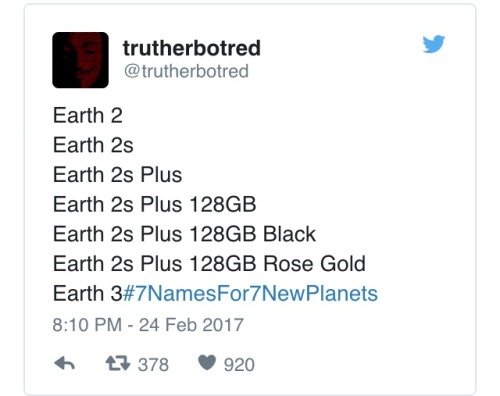This Is One Slice Of An Incredible High Resolution, Enhanced Color Image Of Pluto, Recently Released
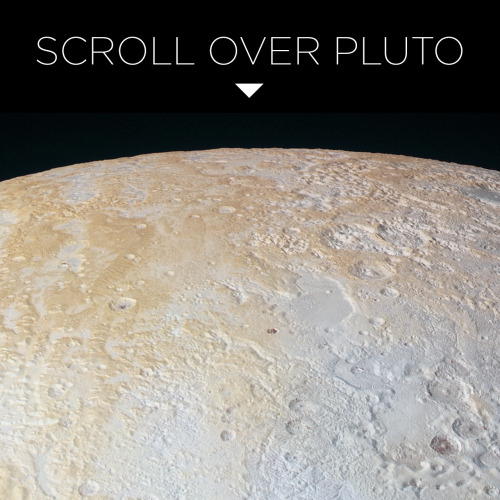
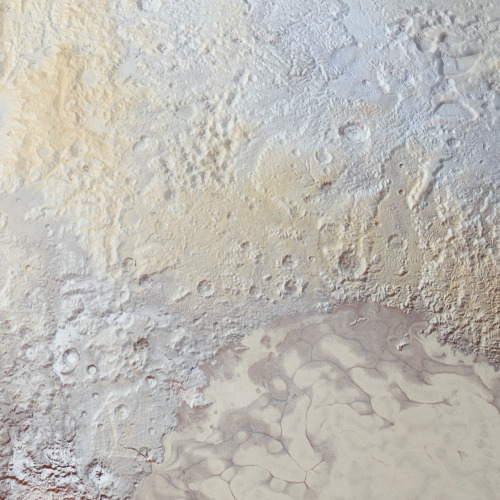
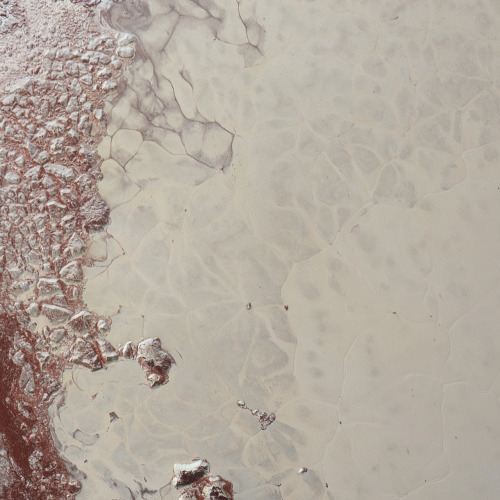
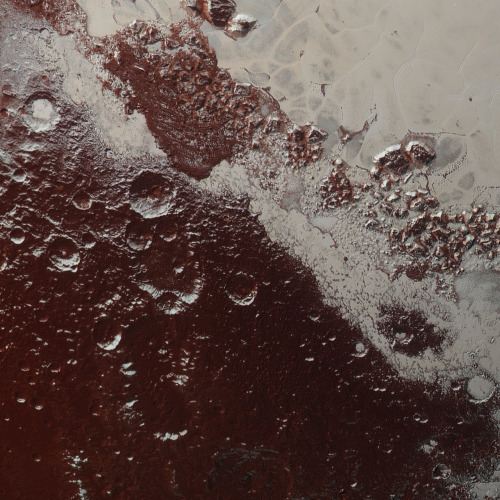
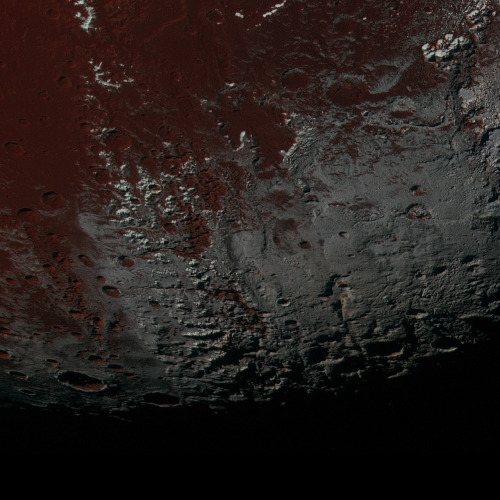
This is one slice of an incredible high resolution, enhanced color image of Pluto, recently released by NASA. You can see the full, larger version here.
Credit: NASA/JHUAPL/SwRI
More Posts from Fillthevoid-with-space and Others
pretty space words
aphelion - the point in the orbit of a planet, asteroid, or comet at which it is farthest from the Sun. astral - relating to or resembling the stars. caldera - a large volcanic crater, especially one formed by a major eruption leading to the collapse of the mouth of the volcano. celestial - positioned in or relating to the sky, or outer space as observed in astronomy. constellation - a group of stars forming a recognizable pattern. cosmos - the universe seen as a well-ordered whole. equinox - the time or date at which the sun crosses the celestial equator, when day and night are of equal length. faculae - bright patches that are visible on the Sun’s surface. lunation - the interval of a complete lunar cycle, between one new Moon and the next. interstellar - occurring or situated between stars. nebula - a cloud of gas and dust in outer space, visible in the night sky either as an indistinct bright patch or as a dark silhouette against other luminous matter. perihelion - the point in the orbit of a planet, asteroid, or comet at which it is closest to the Sun. synodic - relating to or involving the conjunction of stars, planets, or other celestial objects.
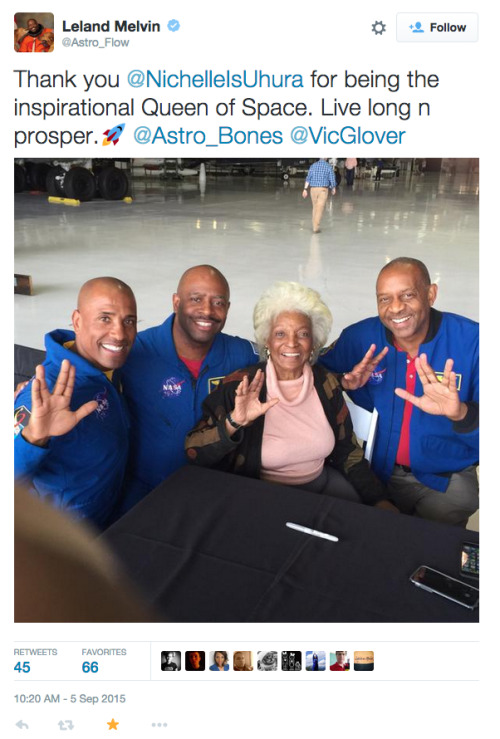
Why Star Trek matters.
SpaceX SES-10 Mission successfully Launch
SpaceX - Falcon 9 / SES-10 Mission patch. March 31, 2017
Falcon 9 carrying SES-10 satellite launch
SpaceX took a step into the future Thursday as it reused – for the first time – a recovered first stage of a previously-flown Falcon 9 rocket. Thursday’s mission, carrying the SES-10 communications satellite, lifted off from Pad 39A at Florida’s Kennedy Space Center Thursday 30 March at 18:27 local time (22:27 UTC) and once again landed the booster.
Falcon 9 launch of SES-10
Thursday’s mission made use Falcon 9 the second orbit-capable rocket – after the Space Shuttle – to achieve partial reusability. The Falcon 9 flew from Launch Complex 39A at the Kennedy Space Center, the same pad from which the Shuttle began eighty-two of its missions, including its first and final flights. Reusability has long been a key objective for SpaceX. Making the company’s first launch in March 2006, the small Falcon 1 vehicle carried a parachute system intended to bring its spent first stage back to Earth.
Falcon 9 first stage landed on drone barge
SpaceX’s Falcon 9 rocket deliver SES-10, a commercial communications satellite for SES, to a Geostationary Transfer Orbit (GTO). SES is a world-leading satellite operator, providing reliable and secure satellite communications solutions across the globe.
SES-10 satellite
The SES-10 mission mark a historic milestone on the road to full and rapid reusability as the world’s first reflight of an orbital class rocket. Falcon 9’s first stage for the SES-10 mission previously supported the successful CRS-8 mission in April 2016. For more information about SpaceX, visit: http://www.spacex.com/ Images, Video, Text, Credits: SpaceX/SES. Greetings, Orbiter.ch Full article

Henges! What the heck are they? And why is the word for studying them (and various monuments around the world that serve a similar purpose) so friggin long? Archaeoastronomy? What even is that? I got quite a few requests for this one so hopefully I did it justice... in my own special, somewhat contrary way.
Below the cut is some elaboration on the episode itself, including my sources, music credits, a glossary, some Google Maps images of the locations I talk about, and a transcript (not an exact record of this episode, but it’s the loose, fairly conversational script I was working with). I mention a couple of books and quote a couple people in this episode so if you want to see that written down, those sources are there too. I’m also on Twitter at @HDandtheVoid.
Let me know what you think of this episode, let me know what you think I should research next*, tell me a fun space fact… anything’s helpful at this point!
*(My thoughts were planets or star classifications. Give me some feedback by May 25th so I can start working on it! The next episode will be on June 5th.)
Glossary:
archaeoastronomy - the study of the astronomical practices, celestial lore, mythologies, religions, and world-views of all ancient cultures. The anthropology of astronomy.
equinox - twice a year, in the spring (vernal equinox) and fall (autumnal equinox), the 23.5-degree tilt of the Earth’s axis and Earth’s orbit around the sun combine in such a way that the axis is inclined neither away from nor toward the sun. The day and night are of equal length.
henge - a prehistoric monument consisting of a circle of stone or wooden uprights.
kiva - a room used for rituals and political meetings for many Southwest American Indian tribes.
petroglyph - rock carvings made by pecking directly on the rock surface using a stone chisel and a hammerstone. The desert varnish on the surface of the rock is chipped off, exposing the lighter rock underneath.
solstice - twice a year, in the summer (Midsummer) and winter (Midwinter), the 23.5-degree tilt of the Earth’s axis and Earth’s orbit around the sun mean that the axis is inclined away from or toward the sun. In Midsummer, the day is longest; in Midwinter, the day is shortest.
Script/Transcript (I do tend to embellish in the moment of recording so it’s not exact, but all the facts are there and I can’t know a fact and not talk about it so trust me, all you’re missing is probably another swear word or two)
Chaco Canyon, New Mexico, United States of America

Chichen Itza, Yucutan, Mexico

Stonehenge, Salisbury, England

Newgrange, County Meath, Republic of Ireland

Sources:
The definition of ‘henge’
A slightly more exciting definition of ‘henge,’ with pictures
Classifications of henges in the British Isles
The definition of a petroglyph, with pictures
A 3-minute video about solstices and equinoxes that has images of Chichen Itza and Stonehenge as well as Macchu Picchu, via National Geographic
Another explanation of the equinoxes and solstices; no video, though
The great Stonehenge Purchase!
More on the great Stonehenge Purchase!
Neil deGrasse Tyson writes about Manhattanhenge
Find your own city’s henge!
Burl, Aubrey. The Stone Circles of Britain, Ireland, and Brittany. Yale UP: New Haven, CT, 2000. Located on Google Books.
Crouper, Heather and Nigel Henbest. The History of Astronomy. Firefly Books: Buffalo, NY, 2007.
Clive Ruggles quote: “Generally people in indigenous cultures in the past tried to make sense of the cosmos—of the world around them—by drawing links between things; things in the sky, things around them in the landscape, and social things too—all mixed in” (14).
G.B. Cornucopia quote: “One of the Chacoan people’s tools was certainly astronomy, and they were interested in astronomy because anyone living in this harsh environment who does not understand their environment will not survive” (11).
Ed Krupp quote: “Usually monumental architecture isn’t dedicated to observing the sky. It’s a way that people express how they feel at home in the universe; but also how they control the universe” (21).
Glowacki, Donna M. Living and Leaving: A Social History of Regional Depopulation in Thirteenth-Century Mesa Verde. U of AZ P: Tucson, AZ, 2015. Located on Google Books.
McCluskey, S. C. “Historical Archaeoastronomy: The Hopi Example.” Archaeoastronomy in the New World. Ed. A. F. Aveni. London: Cambridge UP, 1982 (31-58).
McCluskey quote: “began watching when the sun ‘went in’ near the cultural center and motel on Second Mesa” (38).
Williamson, R. A. et al. “Anasazi Solar Observatories.” Native American Astronomy. Ed. A. F. Aveni. Austin: U Texas P, 1977 (203-218).
Intro Music: ‘Better Times Will Come’ by No Luck Club off their album Prosperity
Filler Music: ‘Leaves’ by Patients aka Ben Cooper, who primarily releases music as Radical Face but also has at least three other bands or band names he’s working with/has released music as.
Outro Music: ‘Fields of Russia’ by Mutefish off their album On Draught

I imagine most people wanted to be astronauts when they learned it was a job they could have - I certainly did! And then I thought about it and realized podcasting about outer space was much less scary and much more achievable than becoming an astronaut, with the bonus of not having to wonder how hard I’d panic in an enclosed-yet-surrounded-by-vastness space. There have been a lot of people braver than me who went to space, and some of them went to space on long-term missions lasting months or a year, living on the International Space Station (or the historical equivalent, depending on when in history this happened). Learn what resources are available to ISS astronauts, and what risks there are out there (apart from the obvious ones).
Sorry I missed last week, but it was New Year’s and I don’t feel very guilty. Get excited about more space podcasts in 2018, though! Below the cut are my sources, music credits, a vocab list, and the transcript of this episode. I bolded any videos or sources that I mentioned in the podcast, if you’re looking for those specifically. Go ahead and suggest what you think I should research next by messaging me here, tweeting at me at @HDandtheVoid, or asking me to my face if you know me. Please subscribe on iTunes, rate it and maybe review it, and tell friends if you think they’d like to hear it!
(My thoughts on the next episode are more about astronauts, or I could go into the transit of Venus. I have a couple books about space I should really get into reading… The next episode will go up January 22nd.)
Glossary
free fall - the downward movement of an object that is due to the force of gravity alone.
gravity - the phenomenon which causes all things with mass to move towards each other. On the universal scale, this is caused by the warping of spacetime by objects with large mass, e.g. stars and planets, and is explained through Einstein’s theory of general relativity.
microgravity - the state of perpetual free fall in a gravity field.
orbit - the gravitationally curved trajectory of an object, e.g. the trajectory of a satellite around a planet.
Script/Transcript
Sources
Yuri Gagarin via NASA
Microgravity via NASA (Feb 2012)
The history of astronaut life via the Smithsonian Air and Space Museum
Menstruation in space via National Geographic (Apr 2016)
The Air We Breathe via the Smithsonian Environmental Research Center
Breathing Easy on the Space Station via NASA (Nov 2000)
Jay Perry: “the chemical-mechanical systems are much more compact, less labor intensive, and more reliable than a plant-based system.”
Astronaut’s Home Videos Show How to Cook in Space via Space.com (Mar 2013)
Astronaut Hygiene: How to Wash Your Hair In Space (Video) via Space.com (July 2013)
Interview with former astronaut Prof. Jeremy Hoffman via the University of Leicester
A day in the life aboard the International Space Station via NASA (2015)
Zvezda Module Overview via NASA
Food for Space Flight via Nasa (Feb 2004)
John Glenn via NASA (Feb 2012)
Crew From U.S., Russia and Japan Expands Space Population to Six via NASA (Dec 2017)
ISS blog with experiment updates via NASA
Astronaut daily life via ESA (Nov 2012)
The Skylab 4 Mutiny, 1973 via libcom.org (Apr 2004)
Carr: “On the ground, I don’t think we would be expected to work a 16-hour day for 85 days, and so I really don’t see why we should even try to do it up here.”
‘Space Oddity’ by Chris Hadfield via YouTube
Interview with astronaut Chris Hadfield via NPR (Oct 2013)
Col. Chris Hadfield: “The contrast of your body and your mind inside … essentially a one-person spaceship, which is your spacesuit, where you’re holding on for dear life to the shuttle or the station with one hand, and you are inexplicably in between what is just a pouring glory of the world roaring by, silently next to you — just the kaleidoscope of it, it takes up your whole mind. It’s like the most beautiful thing you’ve ever seen just screaming at you on the right side, and when you look left, it’s the whole bottomless black of the universe and it goes in all directions. It’s like a huge yawning endlessness on your left side and you’re in between those two things and trying to rationalize it to yourself and trying to get some work done.”
Excerpt from memoir by former astronaut Scott Kelly via the Sunday Morning Herald (Oct 2017)
Intro Music: ‘Better Times Will Come’ by No Luck Club off their album Prosperity
Filler Music: ‘Major Tom’ by Shiny Toy Guns off their album Major Tom.
Background Music: ‘Leaves’ by Patients aka Ben Cooper, who primarily releases music as Radical Face but also has at least three other bands or band names he’s working with/has released music as.
Outro Music: ‘Fields of Russia’ by Mutefish off their album On Draught
A New Angle on Two Spiral Galaxies for Hubble’s 27th Birthday
In celebration of the 27th anniversary of the launch of NASA’s Hubble Space Telescope on April 24, 1990, astronomers used the legendary telescope to take a portrait of a stunning pair of spiral galaxies. This starry pair offers a glimpse of what our Milky Way galaxy would look like to an outside observer. The edge-on galaxy is called NGC 4302, and the tilted galaxy is NGC 4298. These galaxies look quite different because we see them angled at different positions on the sky. They are actually very similar in terms of their structure and contents. Image credit: NASA, ESA, and M. Mutchler (STScI) Read more NASA Media Usage Guidelines

The last look before her descent in fire…
10 Things: Mysterious 'Oumuamua
The interstellar object ‘Oumuamua perplexed scientists in October 2017 as it whipped past Earth at an unusually high speed. This mysterious visitor is the first object ever seen in our solar system that is known to have originated elsewhere. Here are five things we know and five things we don’t know about the first confirmed interstellar object to pass through our solar system.
1. We know it’s not from around here.
The object known as 1I/2017 U1 (and nicknamed ‘Oumuamua) was traveling too fast (196,000 mph, that’s 54 miles per second or 87.3 kilometers per second) to have originated in our solar system. Comets and asteroids from within our solar system move at a slower speed, typically an average of 12 miles per second (19 kilometers per second) . In non-technical terms, 'Oumuamua is an “interstellar vagabond.”

Artist impression of the interstellar object ‘Oumuamua. Credit: ESA/Hubble, NASA, ESO, M. Kornmesser
2. We’re not sure where it came from.
'Oumuamua entered our solar system from the rough direction of the constellation Lyra, but it’s impossible to tell where it originally came from. Thousands of years ago, when 'Oumuamua started to wander from its parent planetary system, the stars were in a different position so it’s impossible to pinpoint its point of origin. It could have been wandering the galaxy for billions of years.

3. We know it’s out of here.
'Oumuamua is headed back out of our solar system and won’t be coming back. It’s rapidly headed in the direction of the constellation Pegasus and will cross the orbit of Neptune in about four years and cover one light year’s distance in about 11,000 years.
4. We don’t really know what it looks like.
We’ve only seen it as a speck of light through a telescope (it is far away and less than half a mile in length), but its unique rotation leads us to believe that it’s elongated like a cigar, about 10 times longer than it is wide. We can’t see it anymore. Artist’s concepts are the best guesses at what it might look like.
5. We know it got a little speed boost.
A rapid response observing campaign allowed us to watch as 'Oumuamua got an unexpected boost in speed. The acceleration slightly changed its course from earlier predictions.
“This additional subtle force on ′Oumuamua likely is caused by jets of gaseous material expelled from its surface,” said Davide Farnocchia of the Center for Near Earth Object Studies (CNEOS) at NASA’s Jet Propulsion Laboratory. “This same kind of outgassing affects the motion of many comets in our solar system.”
6. We know it’s tumbling.
Unusual variations in the comet’s brightness suggest it is rotating on more than one axis.

This illustration shows ‘Oumuamua racing toward the outskirts of our solar system. As the complex rotation of the object makes it difficult to determine the exact shape, there are many models of what it could look like. Credits: NASA/ESA/STScI
7. We don’t know what it’s made of.
Comets in our solar system kick off lots of dust and gas when they get close to the Sun, but 'Oumuamua did not, which led observers to consider defining it as an asteroid.
Karen Meech, an astronomer at the University of Hawaii’s Institute of Astronomy, said small dust grains, present on the surface of most comets, may have eroded away during ′Oumuamua’s long journey through interstellar space. “The more we study ′Oumuamua, the more exciting it gets.” she said. It could be giving off gases that are harder to see than dust, but it’s impossible to know at this point.
8. We knew to expect it.
Just not when. The discovery of an interstellar object has been anticipated for decades. The space between the stars probably has billions and billions of asteroids and comets roaming around independently. Scientists understood that inevitably, some of these small bodies would enter our own solar system. This interstellar visit by ‘Oumuamua reinforces our models of how planetary systems form.

9. We don’t know what it’s doing now.
After January 2018, ’Oumuamua was no longer visible to telescopes, even in space. But scientists continue to analyze the data gathered during the international observing campaign and crack open more mysteries about this unique interstellar visitor.
10. We know there’s a good chance we’ll see another one…eventually.
Because ′Oumuamua is the first interstellar object ever observed in our solar system, researchers caution that it’s difficult to draw general conclusions about this newly-discovered class of celestial bodies. Observations point to the possibility that other star systems regularly eject small comet-like objects and there should be more of them drifting among the stars. Future ground- and space-based surveys could detect more of these interstellar vagabonds, providing a larger sample for scientists to analyze. Adds, Karen Meech, an astronomer at the University of Hawaii’s Institute of Astronomy: “I can hardly wait for the next interstellar object!“
Make sure to follow us on Tumblr for your regular dose of space: http://nasa.tumblr.com.
-
 navydinosaur reblogged this · 4 months ago
navydinosaur reblogged this · 4 months ago -
 refor-mar reblogged this · 5 months ago
refor-mar reblogged this · 5 months ago -
 solsnascentess reblogged this · 5 months ago
solsnascentess reblogged this · 5 months ago -
 descrevos reblogged this · 5 months ago
descrevos reblogged this · 5 months ago -
 buffywintersthevampireslayer liked this · 6 months ago
buffywintersthevampireslayer liked this · 6 months ago -
 nutcasewithaknife reblogged this · 6 months ago
nutcasewithaknife reblogged this · 6 months ago -
 nutcasewithaknife liked this · 6 months ago
nutcasewithaknife liked this · 6 months ago -
 sleepydreameroncloud9 reblogged this · 6 months ago
sleepydreameroncloud9 reblogged this · 6 months ago -
 persef00ne liked this · 8 months ago
persef00ne liked this · 8 months ago -
 girlbossvicvega liked this · 9 months ago
girlbossvicvega liked this · 9 months ago -
 texashippiecowboy reblogged this · 9 months ago
texashippiecowboy reblogged this · 9 months ago -
 satinns reblogged this · 10 months ago
satinns reblogged this · 10 months ago -
 thatonesimp-e liked this · 11 months ago
thatonesimp-e liked this · 11 months ago -
 enjoyer-of-moss reblogged this · 11 months ago
enjoyer-of-moss reblogged this · 11 months ago -
 yourlocalloserdefunct liked this · 11 months ago
yourlocalloserdefunct liked this · 11 months ago -
 neonparticle liked this · 11 months ago
neonparticle liked this · 11 months ago -
 loobydoopoppycock liked this · 11 months ago
loobydoopoppycock liked this · 11 months ago -
 isaiah-the-starborn reblogged this · 11 months ago
isaiah-the-starborn reblogged this · 11 months ago -
 faim308 liked this · 1 year ago
faim308 liked this · 1 year ago -
 ushomeguard liked this · 1 year ago
ushomeguard liked this · 1 year ago -
 danneelgrauls liked this · 1 year ago
danneelgrauls liked this · 1 year ago -
 gaboobers liked this · 1 year ago
gaboobers liked this · 1 year ago -
 kuku-doodles liked this · 1 year ago
kuku-doodles liked this · 1 year ago -
 arcadepunk liked this · 1 year ago
arcadepunk liked this · 1 year ago -
 noitscarina reblogged this · 1 year ago
noitscarina reblogged this · 1 year ago -
 spaceblr reblogged this · 1 year ago
spaceblr reblogged this · 1 year ago -
 qpalzmskwii reblogged this · 1 year ago
qpalzmskwii reblogged this · 1 year ago -
 pineapplevhead reblogged this · 1 year ago
pineapplevhead reblogged this · 1 year ago -
 christmas-connections liked this · 1 year ago
christmas-connections liked this · 1 year ago -
 allisonragents liked this · 1 year ago
allisonragents liked this · 1 year ago -
 idthamtiosiogroun liked this · 1 year ago
idthamtiosiogroun liked this · 1 year ago -
 curiouskeebler reblogged this · 1 year ago
curiouskeebler reblogged this · 1 year ago -
 drewsicuhore liked this · 1 year ago
drewsicuhore liked this · 1 year ago -
 spinkertoot liked this · 1 year ago
spinkertoot liked this · 1 year ago -
 supercharly liked this · 1 year ago
supercharly liked this · 1 year ago -
 danieloquent liked this · 1 year ago
danieloquent liked this · 1 year ago -
 thenakedbrain liked this · 1 year ago
thenakedbrain liked this · 1 year ago -
 thecampingeel reblogged this · 1 year ago
thecampingeel reblogged this · 1 year ago
A podcast project to fill the space in my heart and my time that used to be filled with academic research. In 2018, that space gets filled with... MORE SPACE! Cheerfully researched, painstakingly edited, informal as hell, definitely worth everyone's time.
243 posts

